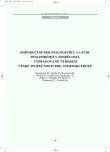-
Medical journals
- Career
Czech Atherosclerosis Society Guidelines for the Diagnosis and Treatment of Dyslipidemia in Adults
Authors: H. Vaverková 1; V. Soška 2; H. Rosolová 3; R. Češka 4; R. Cífková 5; T. Freiberger 6; J. Piťha 7; R. Poledne 7; T. Štulc 4; Z. Urbanová 8; M. Vráblík 4
Authors‘ workplace: III. interní klinika LF UP a FN, Olomouc 1; Oddělení klinické biochemie FN U sv. Anny v Brně 2; II. interní klinika, Centrum preventivní kardiologie LF UK a FN, Plzeň 3; III. interní klinika 1. LF UK a VFN, Praha 4; Pracoviště preventivní kardiologie IKEM, Praha 5; Genetická laboratoř, Centrum kardiovaskulární a transplantační chirurgie, Brno 6; Laboratoř pro výzkum aterosklerózy IKEM, Praha 7; Klinika dětského a dorostového lékařství 1. LF UK, Praha 8
Published in: Čas. Lék. čes. 2007; 146: 1-15
Category: Appendix
Overview
The present guidelines are based on the recommendations published in 2005 entitled “Prevention of Cardiovascular Diseases in Adulthood” summarizing the conclusions of nine Czech medical societies and agree with them in the assessment of individual risk of mortality from cardiovascular disease (CVD) according to SCORE tables. They reflect new research data in pathophysiology of dyslipidemias (DLP) and particularly the results of recent clinical trials of lipid-lowering therapy and their meta-analyses. They establish priorities for the screening and management of DLP, present suitable diagnostic methods, additional investigations of potential use in risk assessment, including some emerging risk factors and detection of sub-clinical atherosclerosis in persons in a moderate-risk category. Major changes include a lower LDL-cholesterol treatment target (< 2.0 mmol/L for all CVD individuals) and a possible use of apolipoprotein B as a secondary target in selected persons (< 0.9 g/L in high risk without CVD, < 0.8 g/L for CVD patients) and nonHDL-cholesterol (< 3.3 mmol/L in high risk without CVD, < 2.8 mmol/L for CVD patients). Therapy of individual DLP phenotypes (monotherapy and combination therapy) as well as basic principles for control examination at lipid-lowering medication are described. Recommended therapeutic lifestyle changes are shown. Enclosed are five annexes: DLP diagnosis; causes of secondary DLP; additional investiga tions of potential use in risk stratification; familial hypercholesterolemia; list of recommended foods; two variants of SCORE tables for risk assessment for the Czech Republic; the scheme of recommended procedures and treatment algorithm in DLP asymptomatic individuals.
Key words:
guidelines, dyslipidemias, LDL cholesterol, apolipoprotein B, cardiovascular diseases.
Labels
Addictology Allergology and clinical immunology Angiology Audiology Clinical biochemistry Dermatology & STDs Paediatric gastroenterology Paediatric surgery Paediatric cardiology Paediatric neurology Paediatric ENT Paediatric psychiatry Paediatric rheumatology Diabetology Pharmacy Vascular surgery Pain management Dental Hygienist
Article was published inJournal of Czech Physicians

Most read in this issue
Login#ADS_BOTTOM_SCRIPTS#Forgotten passwordEnter the email address that you registered with. We will send you instructions on how to set a new password.
- Career

